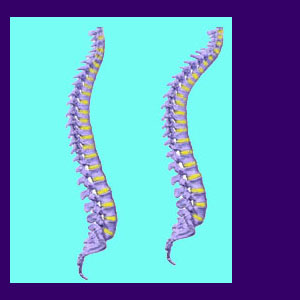
Hypermobile joint back pain is most often seen in patients who are naturally double jointed, have practiced gymnastics, or participated in some forms of vigorous martial arts for extended periods of time, or have been involved in accidents where the integrity of their spinal joints was compromised.
Hypermobile joints are certainly not inherently painful. In fact, most people with hypermobile joints are naturally resistant to spinal joint pain symptoms which may affect those of us with more typical joint capabilities. However, some studies predispose certain types of developed hypermobility conditions to an increased risk for painful arthritic symptoms later in life.
This discussion examines the chances of hypermobile joints being responsible, wholly or in part, for back pain symptomology.
What is Hypermobile Joint Back Pain?
Hypermobile joints describe a condition in which the spinal joints (or any joints in the body) have an unusual range of motion which is above and beyond what is considered typical. In essence, the joints move beyond the range which would cause injury in a typical person. This condition can be congenital or developmental, but in many cases is created through time, effort and hard work spent training in some form of physical activity.
Congenital hypermobility is rarely inherently painful or becomes so over time. Developed hypermobility can become symptomatic and may even lead to spinal instability in some patients.
Hypermobile joints are not usually as stable as joints which are typically limited in their range of motion, since the supporting soft tissues are not designed to protect the joint through such an extensive range of movement.
Hypermobile Spinal Joint Pain
Hypermobile joints can be naturally inborn. These people typically do not have pain or issues involving their joints at any point in life. It seems that in these patients, the anatomy has grown to support the joints and has acclimated to the extended range of motion in most cases. Of course, this is not an absolute, as some people who are naturally double jointed can experience pain in some or all of their overly mobile joints.
The most common serious back pain issues occur in people who are or were involved actively in competitive gymnastics or acrobatics. The training required for these sports is intensive and pushes the limits of the spinal joints beyond their normal capabilities. Some forms of martial arts, such as capoeira, also involve the development of hypermobile joints. Doctors have also seen this condition recently in aging breakdancers.
Hypermobile Joint Back Pain Advisory
There is little which can be done to stabilize the affected joints, without the potential for seriously damaging the spine. Sure, surgeries exist, but can make the condition far worse and are not generally advised for most patients unless severe instability issues exist. It is better to simply reduce the chances for injury and pain through careful monitoring of movement and activities which are high risk. Additionally, keeping the surrounding musculature strong will help maintain integrity in the hypermobile joints and over time, may stabilize them permanently.
Physical therapists and fitness trainers are useful in developing exercise programs to assist patients in stabilizing these potentially problematic joints without surgery. Patients are usually best off following a conservative course of treatment using activity-regulation and exercise, saving operative interventions as last resort treatment options.




